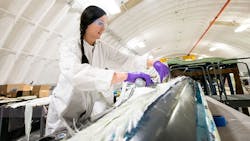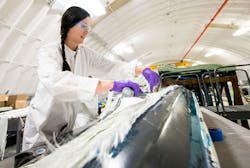Switching from Thermosets to Thermoplastics Could Save Time and Money in Building Wind Turbine Blades
Researchers at the DoE’s Energy’s National Renewable Energy Laboratory (NREL), working with engineers from Arkema Inc of Pennsylvania, have shown it is possible to build wind turbine blades with the necessary structural integrity out of thermoplastic composites.
Currently, blades are made using thermoset resins, which requires more energy and manpower to manufacture than the thermoplastic version. And defective thermoset blades—and there are many—end up in landfills. Thermoplastic blades, on the other hand, could be melted down and reused if there were defective, broken or obsolete. The thermoplastic versions would also be longer or lighter, as well as cost less.
“With thermoset resin systems, it’s almost like when you fry an egg; You can’t reverse it,” says Derek Berry, a senior engineer at NREL. “But with a thermoplastic resin, you can make a blade out of it, then you can heat it to a certain temperature and it melts back down. So you can get the liquid resin back and reuse it.”
NREL has also developed a model to explore the cost benefits of using thermoplastic-resin blades. Current wind turbine blades are primarily made of composite materials such as fiberglass infused with a thermoset resin. They need more heat to cure the resin than a thermoplastic that cures at room temperature, which increases the cost and time to manufacture blades. Thermoplastic blades also take less labor to make, and labor currently accounts for about 40% of a blade. The thermoplastic process, according to researchers, could lower the cost of blades by about 5%.
The NREL team built a 9-meter and a 13-meter composite wind turbine blade. Tests showed these blades would work well and absorb more energy from loads on the blades rather than pass them on to the rest of the turbine. This reduces the wear-and-tear on the turbine.
Thermoplastic resins would also let companies manufacture blades on site, shrinking the problems of transporting larger and longer blades. As blades get bigger, so too do the challenges of getting them from manufacturing site to the wind turbine site.

